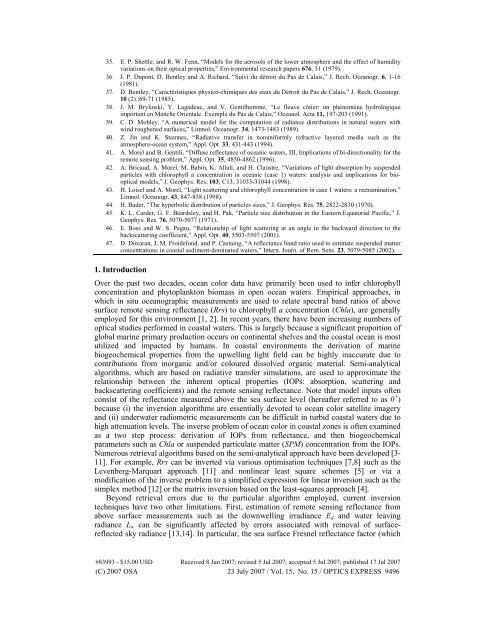Determination of biogeochemical properties of marine particles ...
Determination of biogeochemical properties of marine particles ...
Determination of biogeochemical properties of marine particles ...
You also want an ePaper? Increase the reach of your titles
YUMPU automatically turns print PDFs into web optimized ePapers that Google loves.
35. E. P. Shettle, and R. W. Fenn, “Models for the aerosols <strong>of</strong> the lower atmosphere and the effect <strong>of</strong> humidity<br />
variations on their optical <strong>properties</strong>,” Environmental research papers 676, 31 (1979).<br />
36. J. P. Dupont, D. Bentley and A. Richard, “Suivi du détroit du Pas de Calais,” J. Rech. Oceanogr. 6, 1-16<br />
(1981).<br />
37. D. Bentley, “Caractéristiques physico-chimiques des eaux du Détroit du Pas de Calais,” J. Rech. Oceanogr.<br />
10 (2) :69-71 (1985).<br />
38. J. M. Brylinski, Y. Lagadeuc, and V. Gentilhomme, “Le fleuve côtier: un phénomène hydrologique<br />
important en Manche Orientale. Exemple du Pas de Calais,” Oceanol. Acta 11, 197-203 (1991).<br />
39. C. D. Mobley, “A numerical model for the computation <strong>of</strong> radiance distributions in natural waters with<br />
wind roughened surfaces,” Limnol. Oceanogr. 34, 1473-1483 (1989).<br />
40. Z. Jin and K. Stamnes, “Radiative transfer in nonuniformly refractive layered media such as the<br />
atmosphere-ocean system,” Appl. Opt. 33, 431-443 (1994).<br />
41. A. Morel and B. Gentili, “Diffuse reflectance <strong>of</strong> oceanic waters, III, Implications <strong>of</strong> bi-directionality for the<br />
remote sensing problem,” Appl. Opt. 35, 4850-4862 (1996).<br />
42. A. Bricaud, A. Morel, M. Babin, K. Allali, and H. Claustre, “Variations <strong>of</strong> light absorption by suspended<br />
<strong>particles</strong> with chlorophyll a concentration in oceanic (case 1) waters: analysis and implications for biooptical<br />
models,” J. Geophys. Res. 103, C13, 31033-31044 (1998).<br />
43. H. Loisel and A. Morel, “Light scattering and chlorophyll concentration in case 1 waters: a reexamination,”<br />
Limnol. Oceanogr. 43, 847-858 (1998).<br />
44. H. Bader, “The hyperbolic distribution <strong>of</strong> <strong>particles</strong> sizes,” J. Geophys. Res. 75, 2822-2830 (1970).<br />
45. K. L. Carder, G. F. Beardsley, and H. Pak, “Particle size distribution in the Eastern Equatorial Pacific,” J.<br />
Geophys. Res. 76, 5070-5077 (1971).<br />
46. E. Boss and W. S. Pegau, “Relationship <strong>of</strong> light scattering at an angle in the backward direction to the<br />
backscattering coefficient,” Appl. Opt. 40, 5503-5507 (2001).<br />
47. D. Doxaran, J. M. Froidefond, and P. Castaing, “A reflectance band ratio used to estimate suspended matter<br />
concentrations in coastal sediment-dominated waters,” Intern. Journ. <strong>of</strong> Rem. Sens. 23, 5079-5085 (2002).<br />
1. Introduction<br />
Over the past two decades, ocean color data have primarily been used to infer chlorophyll<br />
concentration and phytoplankton biomass in open ocean waters. Empirical approaches, in<br />
which in situ oceanographic measurements are used to relate spectral band ratios <strong>of</strong> above<br />
surface remote sensing reflectance (Rrs) to chlorophyll a concentration (Chla), are generally<br />
employed for this environment [1, 2]. In recent years, there have been increasing numbers <strong>of</strong><br />
optical studies performed in coastal waters. This is largely because a significant proportion <strong>of</strong><br />
global <strong>marine</strong> primary production occurs on continental shelves and the coastal ocean is most<br />
utilized and impacted by humans. In coastal environments the derivation <strong>of</strong> <strong>marine</strong><br />
<strong>biogeochemical</strong> <strong>properties</strong> from the upwelling light field can be highly inaccurate due to<br />
contributions from inorganic and/or coloured dissolved organic material. Semi-analytical<br />
algorithms, which are based on radiative transfer simulations, are used to approximate the<br />
relationship between the inherent optical <strong>properties</strong> (IOPs: absorption, scattering and<br />
backscattering coefficients) and the remote sensing reflectance. Note that model inputs <strong>of</strong>ten<br />
consist <strong>of</strong> the reflectance measured above the sea surface level (hereafter referred to as 0 + )<br />
because (i) the inversion algorithms are essentially devoted to ocean color satellite imagery<br />
and (ii) underwater radiometric measurements can be difficult in turbid coastal waters due to<br />
high attenuation levels. The inverse problem <strong>of</strong> ocean color in coastal zones is <strong>of</strong>ten examined<br />
as a two step process: derivation <strong>of</strong> IOPs from reflectance, and then <strong>biogeochemical</strong><br />
parameters such as Chla or suspended particulate matter (SPM) concentration from the IOPs.<br />
Numerous retrieval algorithms based on the semi-analytical approach have been developed [3-<br />
11]. For example, Rrs can be inverted via various optimisation techniques [7,8] such as the<br />
Levenberg-Marquart approach [11] and nonlinear least square schemes [5] or via a<br />
modification <strong>of</strong> the inverse problem to a simplified expression for linear inversion such as the<br />
simplex method [12] or the matrix inversion based on the least-squares approach [4].<br />
Beyond retrieval errors due to the particular algorithm employed, current inversion<br />
techniques have two other limitations. First, estimation <strong>of</strong> remote sensing reflectance from<br />
above surface measurements such as the downwelling irradiance E d and water leaving<br />
radiance L w can be significantly affected by errors associated with removal <strong>of</strong> surfacereflected<br />
sky radiance [13,14]. In particular, the sea surface Fresnel reflectance factor (which<br />
#83993 - $15.00 USD Received 8 Jun 2007; revised 5 Jul 2007; accepted 5 Jul 2007; published 17 Jul 2007<br />
(C) 2007 OSA 23 July 2007 / Vol. 15, No. 15 / OPTICS EXPRESS 9496
















